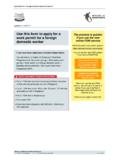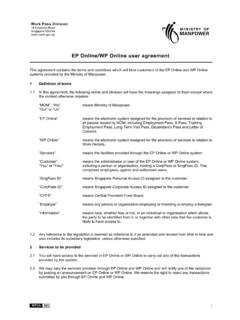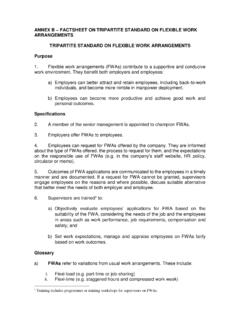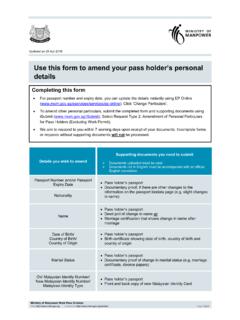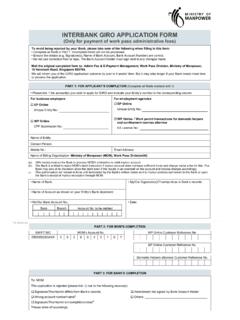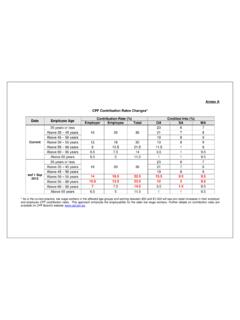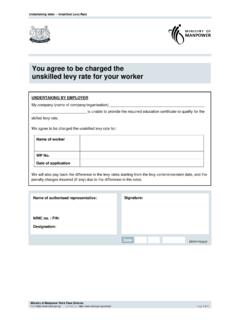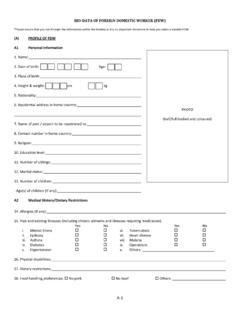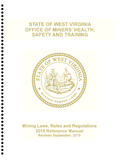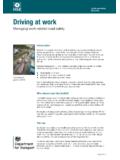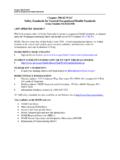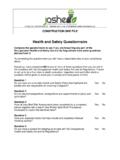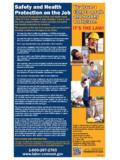Transcription of WORKPLACE SAFETY AND HEALTH (WORK AT …
1 Page 1 of 4 WORKPLACE SAFETY AND HEALTH ( work AT HEIGHTS) ( amendment ) regulations 2014 background The WORKPLACE SAFETY and HEALTH ( work at Heights) regulations was enacted on 1 May 2013, with the key requirements such as Fall Prevention Plan (FPP) and Permit-to- work (PTW) system coming into effect one year later on 1 May 2014 , to allow the industry more time to comply with the regulations . 2 The key provisions in the regulations were: Implementation of the FPP in accordance with any Approved Code of Practice issued by the WORKPLACE SAFETY and HEALTH (WSH) Council; Implementation of the PTW to ensure all SAFETY measures are in place before any hazardous work At height (WAH) can commence; Training requirements for Workers, Supervisors and other WAH personnel to ensure effective conduct and oversight of work performed at heights; and Implementation of SAFETY measures while working on roof, near fragile surfaces and by using the industrial rope access system.
2 Amendments to the regulations WSH (WAH) ( amendment ) regulations 2014 3 The Ministry of Manpower (MOM) has been actively engaging the industry prior to and since the enactment of the WSH (WAH) regulations 2013, which came into force on 1 May 2013. We received feedback from the small and medium enterprises in lower risk sectors, who expressed concerns about operational constraints when implementing the PTW as required under the regulations . Taking these concerns into consideration, MOM has reviewed and refined the PTW requirements to apply only to workplaces defined as Factories1 under the WSH Act, instead of all workplaces.
3 In addition, the requirement for the WAH SAFETY Assessor and Authorised Manager to be a separate person will be removed. These changes are incorporated in the WSH (WAH) ( amendment ) regulations 2014 which came into force on 1 May 2014 . 4 With the exception of the PTW and FPP requirements, all other general provisions under the regulations still apply to all workplaces on 1 May 2014 . 5 With regards to the above amendments, please refer to Annex A for Frequently Asked Questions (FAQs) on related PTW and WAH training requirements for guidance. Companies can email MOM at or visit the WAH webpage at WSH Council s website at if they require further clarifications.
4 1 Factories are defined under the WSH Act as any premises within which persons are employed in any of the prescribed processes and as specified in the Fourth Schedule. Such workplaces typically include the traditional industries such as Construction worksites, Shipyards, Manufacturing Factories. Page 2 of 4 Annex A: Frequently Asked Questions: Permit-to- work (PTW) 1. Under what circumstances do I need to implement the PTW system for WAH? A PTW is required for WAH where a person could fall from a height of more than 3 metres, including falling into depths.
5 Such work activities are deemed as hazardous WAH under the regulations . Under the WSH (WAH) ( amendment ) regulations 2014 which came into effect from 1 May 2014 , the PTW regulatory requirements apply only to workplaces defined as Factories where hazardous WAH is carried out. For WAH where the risk of falling more than 3 metres have been mitigated through adequate and effective edge protection, a PTW may not be required, unless the responsible person (employer or the principal) deemed that a PTW should still be implemented. Such WAH situations where a PTW may not be required, include but are not limited to the following: 1.
6 Working on a flat roof with a perimeter parapet wall of at least 1 metre in height , and no openings or open sides where a person may fall; 2. Working on a mezzanine with safe and proper stair access and effective barricade around the mezzanine perimeter to prevent falls; and 3. Working within the properly barricaded mobile elevated work platform (with the appropriate PPE anchored to designated anchor points at all times). 2. Who is the party responsible for ensuring the effective implementation of PTW system for hazardous WAH? Can the PTW system be implemented through external third-party personnel? The Occupier of the Factory is required to ensure the PTW system is implemented for hazardous WAH in accordance with the regulations .
7 The Occupier of the Factory may implement PTW system for hazardous WAH through a third party, other than his own employees ( appoint personnel of contractor as WAH SAFETY assessor or authorised manager). However, the Occupier still holds the overall statutory duties for implementation of the PTW for hazardous WAH as prescribed under the regulations . The Occupier cannot delegate his statutory duties to the third party by contractual arrangements. 3. Can the PTW system be implemented for multiple WAH work activities or for multiple WAH work locations in the WORKPLACE ? The PTW for WAH can be used for multiple work locations only if it has been assessed that the individual work locations share similar fall from height hazards, and that the control measures taken are applicable and effective in all the work locations covered by the PTW.
8 More details can be found in the Approved Code of Practice for Working Safely at Heights (Clause ) Page 3 of 4 4. Do the regulations specify the duration of each PTW? The regulations do not stipulate the maximum validity period for a PTW for hazardous WAH. However the PTW can be used for extended duration only if it has been assessed to be necessary, and that the control measures taken are effective throughout the entire duration of the PTW. While the maximum duration of such PTW should not exceed seven days, a daily review is required for such PTWs. More details can be found in the Approved Code of Practice for Working Safely at Heights (Clause ) 5.
9 Can the roles of various personnel under the PTW system (Supervisor as applicant of PTW, WAH SAFETY Assessor and Authorised Manager) be combined? MOM has made amendments to PTW requirements under the WSH (WAH) ( amendment ) regulations 2014 where the requirement for the WAH SAFETY Assessor and Authorised Manager to be separate persons has been removed. This refinement was carried out in response to feedback received from Small Medium Enterprises (SMEs) on their operational constraints when implementing the PTW as required under the regulations . In principle, the Authorised Manager and the WAH SAFETY Assessor should where possible, be a separate and dedicated competent person.
10 However, in the event of valid operational and manpower constraints, such as smaller SMEs typically involving small number of personnel during work deployment, a single person may perform concurrent roles of WAH Assessor as well as Authorised Manager, as long as the said person has sufficient experience and training, and able to perform the duties of a WAH SAFETY Assessor as well as an Authorised Manager under the regulations . However, with regards to the PTW Applicant ( Supervisor of the workers who will carry out the WAH activity), he should not concurrently perform the role of a WAH SAFETY Assessor for the same PTW.

